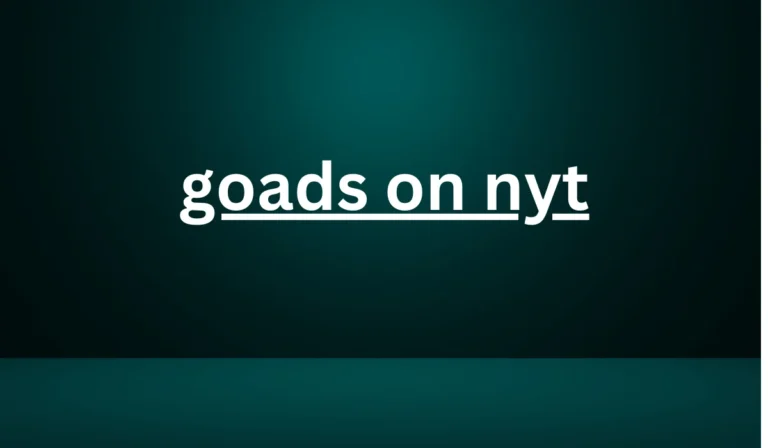In the hastily evolving panorama of cutting-edge journalism, provocation, and controversy have turned out to be pivotal elements. The New York Times (NYT), one of the most influential information groups globally, regularly unearths itself at the center of discussions concerning the position of such provocative elements in its reporting. This article delves into the idea of “goads on NYT,” exploring how intentional provocations form public discourse, and affect readership.
The Nature of Provocation in Journalism
Provocation, within the goads on nyt of journalism, refers to content designed to elicit strong emotional responses, regularly by using hard-winning norms, beliefs, or energy structures. This technique focuses on underreported problems, initiates important thinking, and stimulates public debate. However, it also contains the threat of sensationalism.
Historical Context of Provocative Journalism
Provocative journalism is not a new phenomenon. Historically, newspapers have used bold headlines, scandalous testimonies, and arguable opinions to capture readers’ attention. William Randolph Hearst’s “yellow journalism” in the late nineteenth and early twentieth centuries is a classic example, in which sensationalism turned into hiring to enhance newspaper sales.
The New York Times, with its long-status reputation for rigorous journalism, has also engaged in provocative reporting, albeit in a greater delicate way. The publication has a history of investigative journalism that often uncovers uncomfortable truths and sparks significant societal reactions. From the Pentagon Papers to the greater current exposés on sexual harassment and abuse, the NYT has constantly established the impact of nicely-researched and provocative journalism.
The Modern Landscape: Goads on NYT
In the digital age, the dynamics of journalism have converted appreciably. The opposition to readers’ interest is fiercer than ever, with social media platforms and alternative news resources vying for dominance. In these surroundings, the NYT employs goads — provocative articles or headlines — to keep its relevance and effect.
Case Study: The 1619 Project
One of the maximum terrific examples of goads on NYT is the 1619 Project. Launched in 2019, this initiative aimed to reframe American history by way of setting the outcomes of slavery and the contributions of Black Americans at the middle of the countrywide narrative. The task became both lauded for its ambition and criticized for its historical interpretations, sparking severe debate across the United States of America.
The 1619 Project exemplifies how provocation can serve to provoke vital conversations approximately deeply ingrained societal troubles. By challenging the traditional narrative of American records, the NYT provoked readers to rethink their expertise of the beyond and its effect on the existing. The undertaking’s controversy additionally highlighted the first-rate line among provoking ideas and inciting backlash.
Political Reporting and Opinion Pieces
Political reporting is every other vicinity wherein goads on NYT are regularly discovered. The NYT’s coverage of the Trump administration, for instance, often included provocative headlines and in-depth analyses that drew both praise and grievance. Opinion portions, a staple of the NYT, are often characteristic of provocative viewpoints.
Columnists like Paul Krugman and Maureen Dowd are regarded for his or her sharp, regularly provocative statements on political and monetary troubles. Their writings illustrate how goads can be used to stimulate highbrow discourse and engage a diverse readership. However, they also underscore the ability to polarize audiences, as provocative critiques can deepen ideological divides.
The Role of Social Media
In the age of social media, the impact of goads on NYT is amplified. Articles and headlines designed to initiate are frequently shared extensively, reaching audiences far beyond the NYT’s conventional readership. This virality can enhance the e-book’s effect but additionally exposes it to more scrutiny and complaint.
Social media systems like Twitter and Facebook function as arenas for public debate, where NYT articles emerge as focal factors for discussions. The immediate nature of social media interactions manner that provocative content can quickly generate full-size buzz, each tremendous and poor. This dynamic underscores the significance of responsible journalism, as the results of provocation may be some distance-reaching.
Balancing Provocation and Responsibility
While provocation may be a powerful tool for engaging readers and sparking essential conversations, it should be balanced with a dedication to accuracy, equity, and moral reporting. The NYT, as a leading journalistic organization, faces the undertaking.
Editorial Oversight and Ethical Standards
The goads on nyt employ rigorous editorial oversight to make certain that provocative content meets excessive standards of accuracy and integrity. Fact-checking, thorough studies, and a commitment to supplying a couple of views are crucial additives of this manner. By adhering to those concepts, the NYT targets to differentiate itself from less scrupulous media retailers that prioritize sensationalism over substance.
The Impact on Public Discourse
The use of goads in journalism has a profound effect on public discourse. Provocative articles can increase vital issues, pressure coverage adjustments, and shift societal attitudes. However, they can also contribute to polarization and erode consideration within the media if perceived as biased or sensationalistic.
The goads on nyt position in shaping public discourse through provocation is a testament to its influence and responsibility. By carefully balancing provocation with journalistic integrity. The NYT can play an important position in informing the public at the same time as maintaining its reputation for excellence.
Conclusion
Goads on NYT represents a strategic method to fashionable journalism. Which provocation is used to seize attention, provoke ideas, and power public debate. In a more and more competitive media landscape. The NYT’s use of provocative content underscores its commitment to last applicable and influential.
However, using goads must be tempered with a steadfast commitment to moral journalism. By adhering to excessive standards of accuracy, fairness, and integrity. The NYT can navigate the challenges of provocation whilst continuing to serve as a relied-on supply of information and records. In doing so, it now not simplest engages. Its readership additionally upholds the principles that outline first-rate journalism in the digital age.
